- 2.1 Primary Renewable Energy Sources
- 2.2 Transformations of Primary Renewable Energy Sources
- 2.3 Summary
- Problems
2.2 Transformations of Primary Renewable Energy Sources
Almost all of the service technologies operate using one of the three energy currencies—electricity, heat, and chemical—with electricity dominating the vast majority of applications. Consequently, any discussion of RES transformations is dominated by conversion of the renewable energy forms into electricity. However, it should be recognized that some of the renewable energy sources have the ability to provide other forms of energy currencies as well, and these transformations are discussed in this section as well, in addition to electricity (or power) generation. Electricity is the only energy currency that can be obtained from mechanical energy forms, that is, hydropower energy and wind energy. Solar and geothermal energies can yield both electricity and heat, whereas biomass energy can additionally yield chemicals as well. The electricity generated from the renewable sources can be converted further into heat or used to produce chemicals (hydrogen, for example); however, these secondary transformations are external in scope and not discussed in this book. It should also be noted that synthesizing chemicals using renewable electricity requires external input of raw materials, except in the case of biomass resource. Transformations of the mechanical energy forms are discussed first, followed by those of geothermal, solar, and biomass energy.
2.2.1 Transformations of Mechanical Energy Sources
Nearly 99% of the power generated worldwide involves conversion of mechanical energy, specifically kinetic energy, into electrical energy. This conversion is based on Faraday’s law of electromagnetic induction that provides the fundamental explanation of how the movement of a magnet induces electrical current in a conductor placed in its field [18]. Modern electricity generators operate on this principle and consist of an electromagnet rotor surrounded by a stator wound up in conducting wires. The rotor is driven by a turbine that captures the kinetic energy of the motive fluid inducing the current in conductor on the stator. The motive fluid is steam in thermal power stations, for example, those driven by fossil or nuclear energy. Fossil fuel, usually natural gas based combined cycle power plants also utilize a gas turbine driven by the hot combustion gases to generate electricity via a Brayton power cycle. Additional electricity generation is accomplished in a steam turbine operating a Rankine power cycle6 with the steam generated through heat transferred from the combustion gases exiting the gas turbine [2].
The two mechanical forms of renewable energy—hydropower energy and wind energy—are converted to electricity using the same principle. As mentioned in the previous section, water stored in the reservoir type of hydropower plants possesses potential energy due to the force of gravity. This potential energy is converted into kinetic energy of the turbine as it is released through the penstock past the turbine located at a lower elevation, as shown in Figure 2.6. The turbine drives the rotor of the generator located in the powerhouse, generating the electricity. Figure 2.8 shows the schematic of a typical hydroelectric turbine. The RoR hydroelectric plants do not have a reservoir of stored water, and the kinetic energy of the flowing water is transferred directly to the turbine.
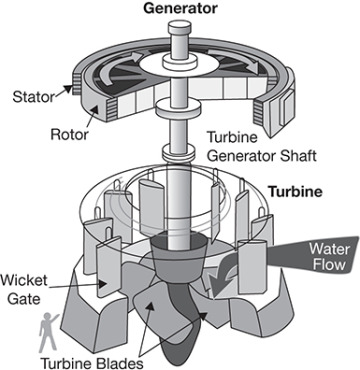
FIGURE 2.8 Schematic of a hydroelectric turbine and generator.
Source: U.S. Army Corps of Engineers, https://www.usgs.gov/special-topic/water-science-school/science/hydroelectric-power-how-it-works?qt-science_center_objects=0#qt-science_center_objects.
Wind turbines perform in the same manner as the turbines in the RoR hydropower plants; that is, they capture the kinetic energy of the wind and employ the same principle of electromagnetic induction to generate electricity. The power rating of a wind turbine depends upon the area swept by the blades of the turbine, and most large-scale wind turbines are of the horizontal axis type, that is, the axis of rotation is parallel to the ground and the wind direction. A modern horizontal axis wind turbine (HAWT) in a commercial wind farm installation may have blades that are 50 m long and a power rating of up to 5 MW. The hub of the rotor may be located at a height of 100 meters above the ground to take advantage of the increased wind velocities compared to those near the surface of the earth [16]. Vertical axis wind turbines (VAWTs), where the axis of rotation is perpendicular to the ground, are less common and have smaller power ratings. These VAWTs may find niche applications in smaller residential settings and locations where wind patterns are not consistent or where larger installations are not permitted out of aesthetic or ecological considerations. Figure 2.9 shows a schematic of both horizontal axis and vertical axis turbines. The rotational speed of the blades in a wind turbine is typically 30–60 rpm, and the hub of the turbine contains a gearbox that steps it up to 1200–1500 rpm, which is within the range needed by the generator [19].
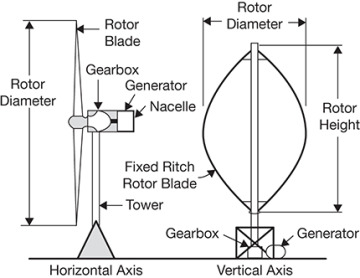
FIGURE 2.9 Horizontal and vertical axis wind turbines.
Source: U.S. Environmental Protection Agency, https://www.epa.gov/sites/production/files/2019-08/documents/wind_turbines_fact_sheet_p100il8k.pdf.
Unlike fixed windmills of the past, modern HAWTs contain sophisticated control systems to maintain the orientation of blades perpendicular to the wind to ensure uninterrupted power generation despite any changes in the wind direction. The blades of the turbine have also evolved into longer, sleeker ones that are significantly quieter, despite their size, and have superior aerodynamic performance. Figure 2.10 shows the innovative transformations in blade design over the past four decades [16].
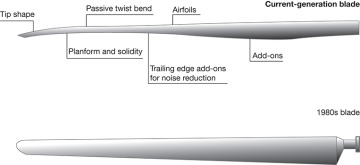
FIGURE 2.10 Evolution of wind turbine blades.
Source: Veers, P., et. al., “Grand Challenges in the Science of Wind Energy,” Science, Vol. 366, 2019, eaau2027 (9 p).
Wind energy installations can be located onshore or offshore, with offshore installations offering the advantages of the availability of a higher-quality wind resource and potential use of larger wind turbines while also avoiding utilizing large land areas that can be repurposed for other applications [12].
Hydropower energy, from reservoir-type plants, can be expected to generate electricity at a consistent rate; however, electricity generation from wind energy installations can be highly variable due to daily and seasonal variations. Possible solutions to improve the reliability and consistency of power generation from variable resources are presented in Chapter 6, Hybrid Energy Systems.
2.2.2 Transformations of Geothermal Energy
Geothermal energy has been utilized for several millennia by human beings, in direct heating applications, such as bathing, washing, and cooking. Direct utilization of geothermal energy in geothermal heat pumps, space heating, and bathing, accounts for 90% of such applications. Direct utilization of geothermal energy also includes industrial and agricultural applications, for example, for food dehydration, milk pasteurization, industrial process heat, and aquaculture pond heating [20]. Geothermal energy usage in direct applications increased by more than 400% over nearly two decades, rising from ~38 TWh in 1997 to ~164 TWh in 2015 [20, 21]. More than half of these applications involve geothermal heat pumps, wherein residential and commercial buildings are heated in winter and cooled in summer by circulating water in a closed loop between the building and subsurface with heat transfer areas provided in each location.
Compared to direct use, converting geothermal energy into electricity is a relatively recent phenomenon that started in the early 20th century. Wells drilled into geothermal reservoirs transport the geothermal fluids to the surface, where thermal energy is extracted from them via a power conversion cycle to generate electricity. Fluids present in the geothermal energy systems are primarily of two types: vapor-dominated systems consisting mainly of steam and liquid-dominated systems consisting of brine [22]. The vapor-dominated systems may typically contain some fraction of noncondensable gases as well. For vapors containing >15% noncondensables, a direct-intake, noncondensing cycle may be used for power generation, wherein the vapor is fed directly to a turbine and exhausted to the atmosphere without attempting to condense the steam [9]. Condensing systems are used for brine-dominated systems, as well as where the vapor consists mostly of dry or saturated steam. In a more general case, the geothermal fluid extracted via a production well consists of brine or a mixture of vapor and brine, and in these cases, single- or double-flash systems are used to generate additional steam from brine. The steam is fed to a turbine to generate the electricity via the Rankine cycle, and the condensate along with the concentrated brine is injected back into the geological formation via an injection well that is distinct from the production well [22]. The fluids present in geothermal energy reservoirs vary greatly with respect to their temperatures, and in some cases, the geothermal fluid may simply be hot water. In such cases, a low-boiling secondary fluid (ammonia or isobutene, for example) is vaporized by heat exchange with the geothermal fluid and used to operate an organic Rankine cycle or Kalina cycle for power generation. These types of plants are called binary-cycle plants. Figure 2.11 shows the conceptual schematics of the three different types of closed-loop geothermal power plants [23].
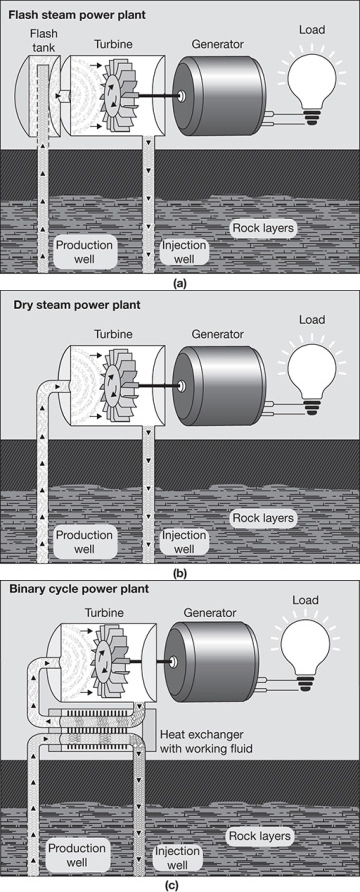
FIGURE 2.11 Types of geothermal power plants.
Source: U.S. Department of Energy, Energy Efficiency & Renewable Energy (public domain), https://www.eia.gov/energyexplained/geothermal/geothermal-power-plants.php.
As mentioned earlier, temperatures of geothermal energy resources vary greatly, and this puts constraints on the type of technology that can be used to harness that energy, as well as the potential applications of the resource. Typically, for any geothermal energy source, a listing of potential applications is developed, arranged in the order of decreasing temperatures and corresponding technology used for those applications. This listing is called the Lindal diagram,7 which serves to identify, first the maximum temperature and the corresponding application that is feasible with the geothermal energy resource, and second, the potential to maximize the use of the resource through developing a heat exchange network to cascade through applications requiring progressively lower temperatures [24]. A sample Lindal diagram is shown in Figure 2.12.
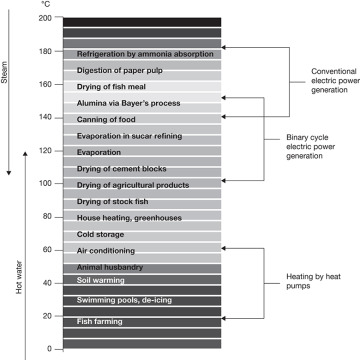
FIGURE 2.12 Example of a Lindal diagram.
Source: Moya, D., C. Aldas, and P. Kaparaju, “Geothermal Energy: Power Plant Technology and Direct Heat Applications,” Renewable and Sustainable Energy Reviews, Vol. 94, 2018, pp. 889–901.
As can be seen from the above figure, electricity generation via conventional power cycles is the first preference, provided high-temperature steam is available. Lower temperatures would drive the choice to binary power cycles, followed by direct thermal applications. The particular applications shown in Figure 2.12 are of relevance to a geothermal field in an agricultural/fisheries setting. The listing will be quite different for the geothermal field, which is in the proximity of a mine, as shown in reference 24. A situation-specific Lindal diagram needs to be developed to optimize the exploitation of any geothermal field.
2.2.3 Transformations of Solar Energy
The simplest utilization of solar energy is direct low-temperature applications, such as domestic water heating, solar cooking, space heating, and crop drying [21]. Energy management of buildings—heating, cooling, or ventilation—can be accomplished via an active or passive system utilizing solar thermal energy. As significant as these applications are, particularly from the environmental perspective of displacing polluting fuels used for domestic applications (cooking, heating, etc.) in developing economies, it is the conversion of solar energy into electrical energy that is of primary interest for large-scale systems and industrial applications.
Conversion of solar energy into electrical energy is effected in one of two ways: (1) Concentrated solar power (CSP) systems involve focusing solar radiation into a concentrated beam that transfers its thermal energy to a fluid, raising its temperature. This thermal energy conducted by the fluid is typically used to generate steam to drive a power cycle to generate electricity [25]; (2) photovoltaic (PV) systems involve direct conversion of solar energy using the photoelectric effect [26]. PV technology is one of the few exceptions in power generation systems wherein electricity is generated without any intermediate conversion to mechanical energy by using turbines [27].
Technologies for the conversion of solar energy—both CSP and PV systems—into electrical energy are discussed in detail in Chapter 3, Transformations and Chemical Processes in Solar Energy Systems.
2.2.4 Transformations of Biomass Energy
Biomass, particularly from agricultural/forest residues and products and organic waste streams, has been used historically for heating and cooking by direct combustion and continues to be used in this manner in many developing countries. As mentioned earlier, such use is unsustainable, causes environmental pollution, and has adverse health effects on human beings. Furthermore, this traditional burning of biomass hardly allows the energy content of the biomass to be used efficiently and effectively for more complex, value-added applications. Modern transformation technologies enable conversion of biomass to electricity and chemicals in addition to heat, expanding the utility of biomass energy to industrial processes, transportation applications, and consumer services.
Biomass energy is transformed into other forms of energy—electricity, thermal energy, and chemical energy—via a number of different processes. The two major types of conversion processes are thermochemical conversion processes and biochemical conversion processes. Figure 2.13 shows further details of specific processes that are categorized under these types [21]. Thermochemical processing includes direct combustion, pyrolysis, and gasification, while biochemical processing involves digestion or fermentation. Direct combustion of biomass can yield both electricity and heat, while gasification and pyrolysis can also yield other chemicals that can also be used as fuels. Electricity and chemicals can also be obtained through biochemical processing, while extraction processes can yield chemicals, typically biodiesels.
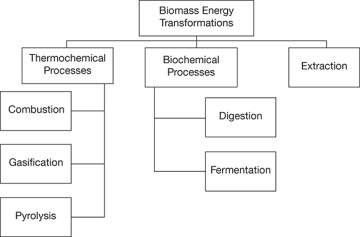
FIGURE 2.13 Biomass energy conversion processes.
Transformations of biomass energy are described in detail in Chapter 4, Transformations and Chemical Processes in Biomass Energy Systems. Transformation of mechanical energy and other forms of energy are described in Chapter 5, Transformations and Chemical Processes in Mechanical, Geothermal, and Ocean Energy Systems.
